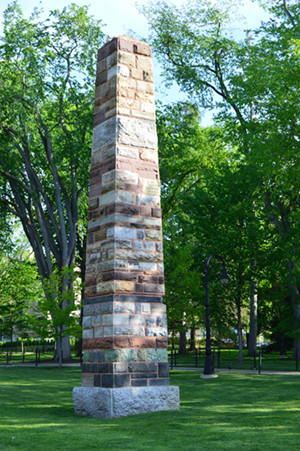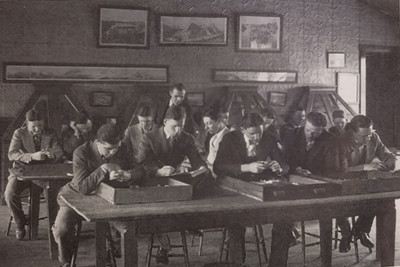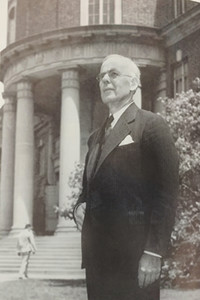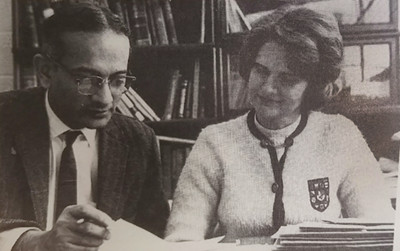The College of Earth and Mineral Sciences has a rich history dating back more than a century, from the original focus on mining engineering, to today's interdisciplinary focus on earth, energy, and materials sciences and engineering.
1859
The University (then known as the Pennsylvania Farmers' High School) offers its first course in geography and meteorology, a required course in the scientific and agricultural program.
1890
Penn State Board of Trustees approves the establishment of the Department of Mining Engineering.
1896
The growing Department of Mining Engineering is renamed to the School of Mines; Magnus Ihlseng serves as dean until 1899.
 Construction on Penn State's Obelisk finishes. Located adjacent to the Old Main Mall, the Obelisk is a collaborative effort of faculty, students, and the Pennsylvania Mining Industry, and it contains more than 280 stones from 139 locations across the Commonwealth of Pennsylvania. The Obelisk supports research on the durability and characteristics of building stone, displays the various stones for builders and architects to examine, and, since the stones are arranged in geological sequence, aids instruction in Earth Sciences.
Construction on Penn State's Obelisk finishes. Located adjacent to the Old Main Mall, the Obelisk is a collaborative effort of faculty, students, and the Pennsylvania Mining Industry, and it contains more than 280 stones from 139 locations across the Commonwealth of Pennsylvania. The Obelisk supports research on the durability and characteristics of building stone, displays the various stones for builders and architects to examine, and, since the stones are arranged in geological sequence, aids instruction in Earth Sciences.
1906
The School of Mines and Metallurgy is formed.
1907
A program in metallurgy, a predecessor to today's materials science and engineering program, is offered for the first time.
1909
A major in mining geology is established in the School of Mines and Metallurgy. The first B.S. degree in mining geology is conferred in 1912 and the first M.S. degree is first conferred in 1913.
1923
The Department of Ceramic Technology is formed, another predecessor to today's materials science and engineering program.
1928
 A bachelor of science degree in geology is first offered, replacing the degree in mining geology.
A bachelor of science degree in geology is first offered, replacing the degree in mining geology.
1929
Dr. Edward Steidle renames the school to the School of Mineral Industries, "symbolizing a philosophy that the school would provide an all-inclusive educational program for the mineral industries of the state and the nation."
1930
Construction on the Mineral Industries Building (now known as the Steidle Building) is completed.
The Mineral Industries Library is created; today this is known as the Fletcher L. Byrom Earth and Mineral Sciences Library.
1931
Dr. Raymond Murphy is the first professionally trained geographer to join Penn State's faculty; he serves as assistant professor of economic geography.
The school's Department of Geology establishes a major in petroleum and natural gas engineering, offering B.S., M.S., and Ph.D. degrees.
The college publishes its first issue of the Mineral Industries Bulletin to promote research and increase university-industry collaborations.
1932
The University's geography major/curriculum is first offered to students.
The Department of Fuel Technology, the first of its kind in the U.S., is established. This program is a predecessor to the Department of Materials Science and Engineering.
1933
The Department of Petroleum and Natural Gas Engineering is established; today it is housed within the John and Willie Leone Family Department of Energy and Mineral Engineering.
1934
A program in fuel science is first offered; this is a predecessor to today's materials science and engineering program.
The first weather forecasting course is taught in the Department of Mining Engineering.
1935
 Dean Edward Steidle holds first public exhibition of artwork that he collected related to the mineral industries. The Mineral Industries Art Gallery holds its first public exhibition. Artwork is displayed in the dean's office and conference room because there is no dedicated museum.
Dean Edward Steidle holds first public exhibition of artwork that he collected related to the mineral industries. The Mineral Industries Art Gallery holds its first public exhibition. Artwork is displayed in the dean's office and conference room because there is no dedicated museum.
1937
The master of education in geography is offered to students; the first M.Ed. degree in geography is granted in 1939.
1941
The Department of Geology, Mineralogy and Geography is renamed to the Department of Earth Sciences.
1942
The Mineral Industries Art Gallery is formally opened on April 11. The gallery is located in a new wing of the Mineral Industries Building.
The first Ph.D. in petroleum and natural gas engineering is granted by Penn State. The degree is the third such degree granted in the U.S.
1944
The School of Mineral Industries is reorganized to include the Department of Earth Sciences, the Department of Mineral Engineering, and the Department of Materials Technology.
The Division of Meteorology, part of the Department of Earth Sciences, is formed.
1945
The Division of Geography forms when the School of Mineral Industries is reorganized by Dean Edward Steidle. Dr. E. Willard Miller serves as first chief of the division, which offers B.S., M.S., and Ph.D. degrees.
The Department of Mineral Engineering is formed.
1946
The first M.S. and Ph.D. in geography are offered to students; the first M.S. is granted in 1947 and the first Ph.D. is granted in 1949.
A program in mineral economics — the first of its kind in the U.S. — is formed at Penn State. The first B.S. degree in this program is awarded in 1947, the first M.S. in 1948, and the first Ph.D. in 1954.
1947
The first M.S. and B.S. degrees in Meteorology are awarded; first Ph.D. in meteorology is conferred in 1949.
1949
Cornerstone exercises are held to inaugurate the opening of the the Mineral Sciences Building (now known as Hosler Building).
The Combustion Laboratory, the predecessor to today's EMS Energy Institute, is founded.
1951
First geosciences-related Ph.D. is granted. Initially, degrees are granted in geophysics, geology, mineralogy, and geochemistry.
1952
The Materials Characterization Laboratory is founded by Drs. Thomas Bates and Elburt Osborn. Today, the laboratory is one of the main research facilities in the Millennium Science Complex.
1953
The Pennsylvania State College is renamed to the Pennsylvania State University, and the School of Mineral Industries becomes the College of Mineral Industries.
1954
The Division of Geography becomes the Department of Geography.
The Division of Meteorology becomes the Department of Meteorology.
1962
 Rustum Roy founds the Materials Research Laboratory in the College of Earth and Mineral Sciences. This is the predecessor to today's Materials Research Institute.
Rustum Roy founds the Materials Research Laboratory in the College of Earth and Mineral Sciences. This is the predecessor to today's Materials Research Institute.
The Division of Earth Sciences was organized into four units: Geography, Meteorology, Geology and Geophysics, and Geochemistry and Mineralogy.
1964
Construction on the Mineral Industries Building is completed. Today, this is known as the Deike Building.
1965
Mineral Industries Building is dedicated and renamed to the Deike Building in honor of renowned alumni George Deike, Sr., George Deike, Jr., and their family.
1967
The Department of Materials Science and Engineering is formed.
1972
The college begins offering a program in polymer science through the Department of Materials Science and Engineering.
1978
The Mineral Industries Building is renamed to the Steidle Building in honor of Edward Steidle, dean emeritus of the College of Earth and Mineral Sciences.
1979
Under the leadership of Dean Charles Hosler, construction on the Walker Building is completed. Today, this houses the administrative offices for the Department Meteorology and Atmospheric Science, and the Department of Geography.
1981
The Obelisk Society is formed to give special honor and recognition to individuals who make extraordinary contributions to the college.
1986
The Earth System Science Center is founded as an interdisciplinary research center, bringing together students and faculty in meteorology, geosciences, and geography. The first director is Eric Barron (now president of Penn State). Today, Michael Mann is the director of the center.
1987
Dr. Peter Gould becomes the University's first Evan Pugh Professor of Geography, the highest distinction Penn State bestows on faculty members.
1989
The Graduates of Earth and Mineral Sciences (GEMS) Alumni Society for EMS is formed with an initial membership of nearly 5,000 alumni.
1990
Stanley Suboleski is the first college faculty member to be named to an endowed professorship, named the Centennial Career Development Professorship in Mining.
1993
The college begins offering a program in geo-environmental engineering through the the John and Willie Leone Family Department of Energy and Mineral Engineering.
1994
The Mineral Sciences Building is renamed in honor of Charles Hosler, dean emeritus of the college.
1998
The Department of Mineral Engineering is renamed to the Department of Energy and Geo-Environmental Engineering.
1999
The EMS Environment Institute is formed. This is a predecessor to today's Earth and Environmental Systems Institute (EESI).
The Department of Geography begins offering its first online program, a master's certificate in geographic information systems.
2000
The college begins offering a program in environmental systems engineering through the John and Willie Leone Family Department of Energy and Mineral Engineering.
2001
The college launches its Science Diving educational program.
Under the leadership of Dean John Dutton, the college establishes an institute-focused on developing the best online courses possible, named the e-Education Institute.
2003
The college's e-Education Institute is renamed the John A. Dutton e-Education institute to honor Dr. Dutton, former dean of the College of Earth and Mineral Sciences, who was instrumental in creating the institute's vision.
2004
The college begins offering a program in energy business and finance through the John and Willie Leone Family Department of Energy and Mineral Engineering, and an online master's in geographic information systems taught through Penn State World Campus.
The EMS Environment Institute is renamed to the Earth and Environmental Systems Institute (EESI), one of the main research institutes today in EMS and part of the Penn State Institutes of Energy and the Environment.
2005
The college begins offering a program in geobiology through the Department of Geosciences.
2007
The college begins offering a program in energy engineering through the the John and Willie Leone Family Department of Energy and Mineral Engineering
2008
A master of education in earth sciences is first offered online through Penn State World Campus.
The John A. Dutton E-Education Institute launches its Open Educational Resources initiative, which allows users to access the content of more than 100 online courses created by the Dutton Institute.
2010
The online B.A. in energy and sustainability policy is first offered through Penn State World Campus.
Penn State begins offering a master's degree in homeland security; the geospatial intelligence option is administered by EMS and taught by EMS faculty.
Longtime college supporters John and Willie Leone donate $5 million, endowing the John and Willie Leone Family Department of Energy and Mineral Engineering and creating opportunities such as a faculty chair, undergraduate scholarships, and graduate fellowships.
2013
Penn State begins offering intercollege, online master’s degree in renewable energy and sustainability systems online through Penn State World Campus. EMS faculty and instructors teach the majority of courses required for the program's four options.
2016
The Department of Meteorology is renamed to Department of Meteorology and Atmospheric Science to reflect the department's expanded research and teaching focus.
Extensive renovations on Steidle Building, to improve research and teaching space, are complete.


